By Aaron Filbeck, CAIA, CFA, CFP®, CIPM, FDP, Managing Director, Head of UniFi by CAIA™.
The post-GFC to pre-COVID period was a good run for real estate investors (assuming you could afford to buy). Since then, real estate has had a tough couple of years. Depending on the proxy, commercial real estate prices are down 5% to 35% from their highs in 2022 through the first few months of this year. For those who enjoy annualized returns, many REIT ETFs (a quasi-proxy for core real estate) officially have a negative 3-year return through April 2024.
Are We There Yet?
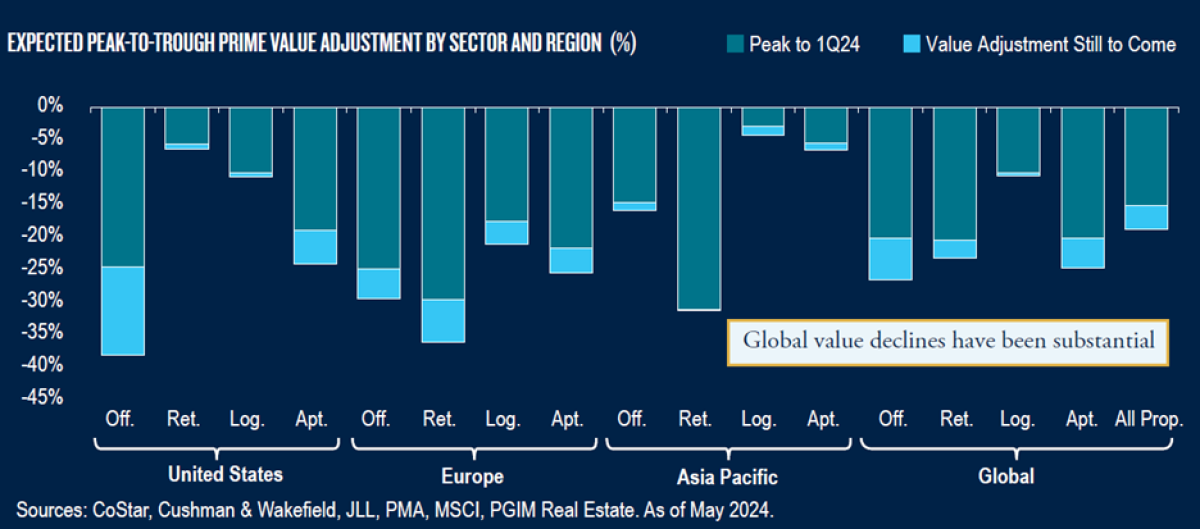
The big question is whether or not there’s still pain in the future, or if the damage is done? According to PGIM’s 2024 Global Real Estate Outlook, it depends on the sector and the region. In the U.S., their view is that the office and apartment sectors still have some room to fall, whereas retail’s highly publicized decline seems to be at an end. Conversely, Europe looks like it may have some additional room across the board and Asia’s pain is expected to be over.
Blackstone shared a similar sentiment a few months back, providing three things to think about:
- Borrowing costs have come down from their highs, inflation is cooling, and credit formation is once again happening across real estate
- New construction is down anywhere from 30-70% since their highs a few years ago— constrained supply of new properties could “help lead to a sharper recovery than the market expects.”
- Not all sectors are made the same— office properties may continue to lag, whereas data centers have a secular trend that supports continued growth.
That last point is important, and a good reminder that much of the headlines are focused on the “big shiny office buildings” in large metropolitan centers, yet these types of properties only represent 10-15% of the commercial real estate complex.
This Isn’t Your Millennial’s Real Estate Market
Even if the consensus is that real estate prices are bottoming and we’re entering a “generational buying opportunity,” the fact is that many of the underlying factors that drove real estate markets post-GFC and pre-COVID have changed. I’ll touch on three: credit conditions, inflation, and supply.
Credit Conditions
Perhaps unlike the longer-term trend of cash flow-based lending to middle-market companies moving to the private sector, banks still hold a significant portion of debt in the real estate market. This is even more true across Europe and Asia where banks hold roughly two-thirds to 90%+, respectively.
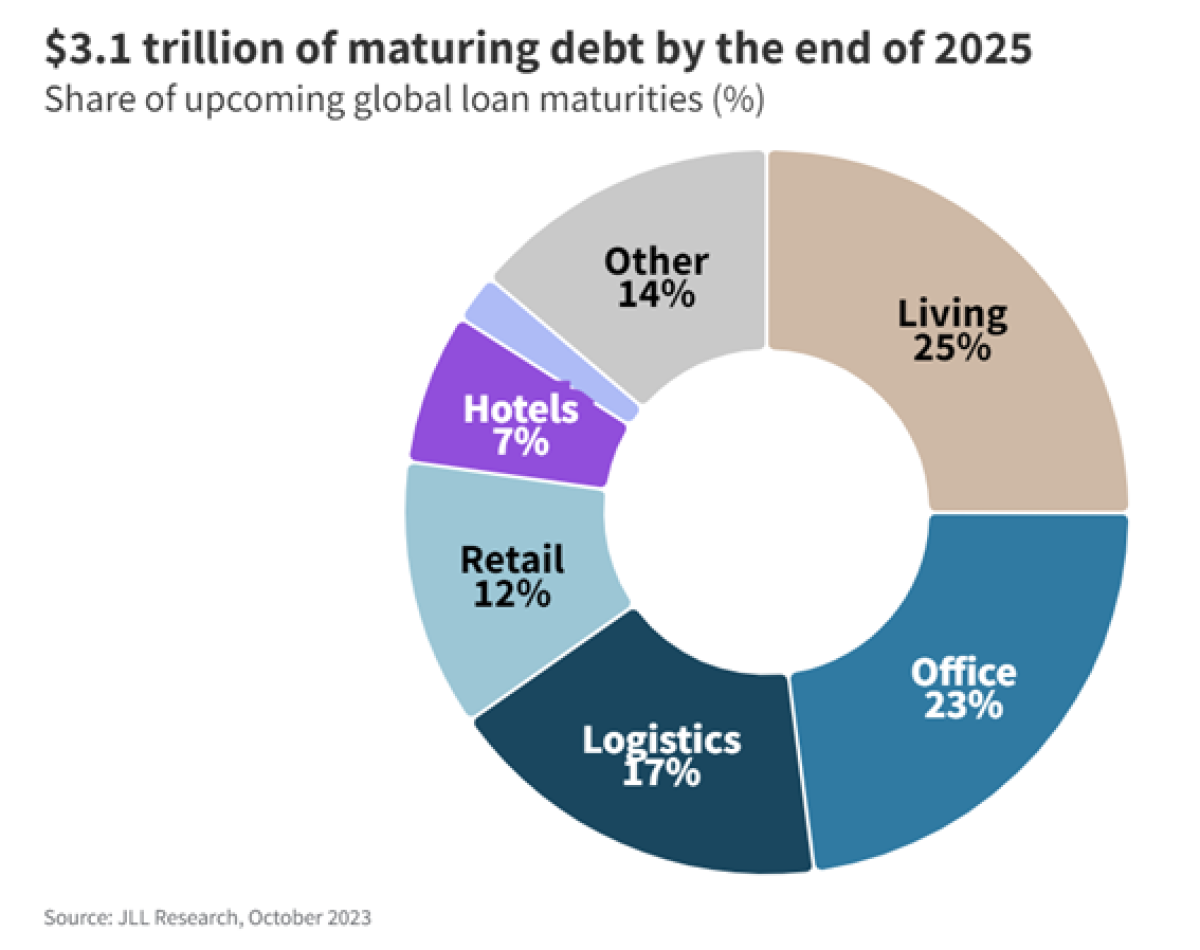
However, recent research from JLL highlights the fact that $3.1 trillion in real estate debt comes due by the end of 2025. Many of these loans are floating rate and were made a few years ago, when interest rates were much lower.
Given that banks have a much more conservative mandate and less flexibility than a typical investment manager, they may not be willing to lend as much to these real estate operators. Given their conservative nature, banks may view these properties as over levered in a regime with higher interest rates and lower equity values. As a result, many investors expect a funding gap to be filled. The net result? We’re likely to see transaction activity in the private markets increase.
To put some numbers around this, an outlook from KKR asks the rhetorical question, “If bank lending recedes to 40% of the roughly $5.8 trillion commercial real estate debt market from 50%, it leaves a gap of over $500 billion. Who will be able to fill that gap?”
Inflation
If you ask two different research firms about the relationship between real estate and inflation, you’re likely to get two different answers. However, there’s a general consensus that real estate, especially core real estate, has a positive relationship with inflation. However, this relationship varies by the level of inflation, according to both American Realty Advisors and NAREIT, and the relationship appears to be more consistent when it comes to income as opposed to price appreciation, as shown below.
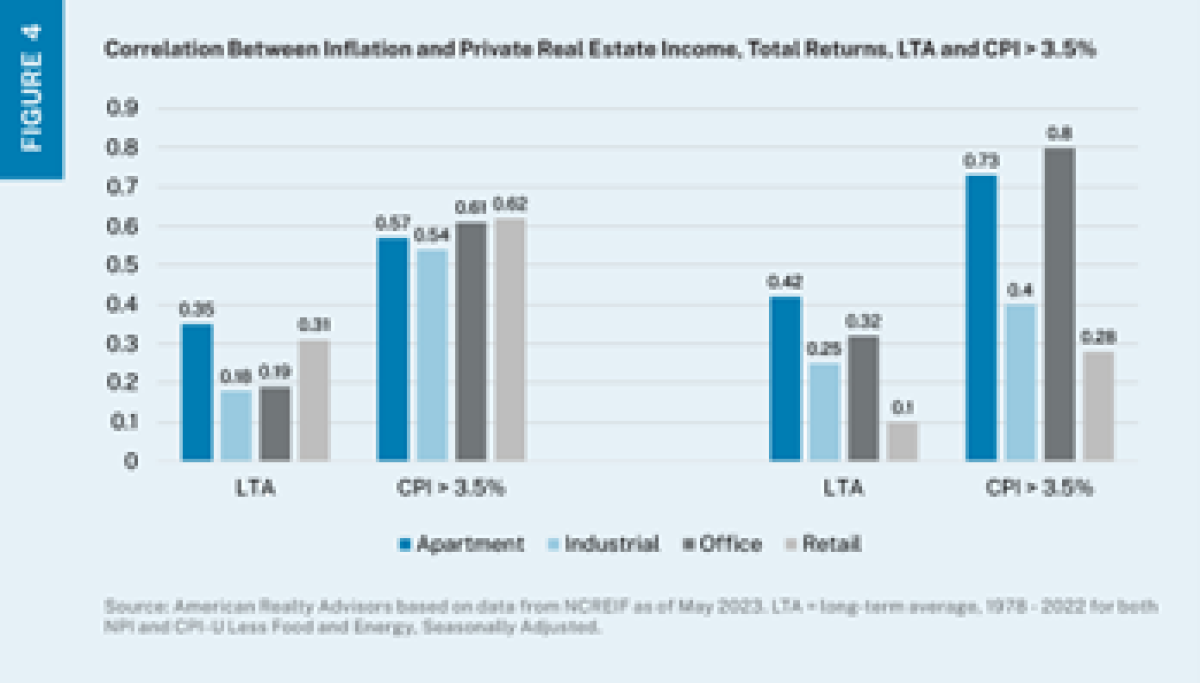
It feels like we’ve been preparing for years for higher inflation, and we finally got it (yay?). During that preparation period, we touted the importance of allocating inflation-sensitive assets, like real estate, to protect our portfolios. Now, on the other side of inflations rise and fall in the early 2020s, we have to bring our expectations back down to a new reality.
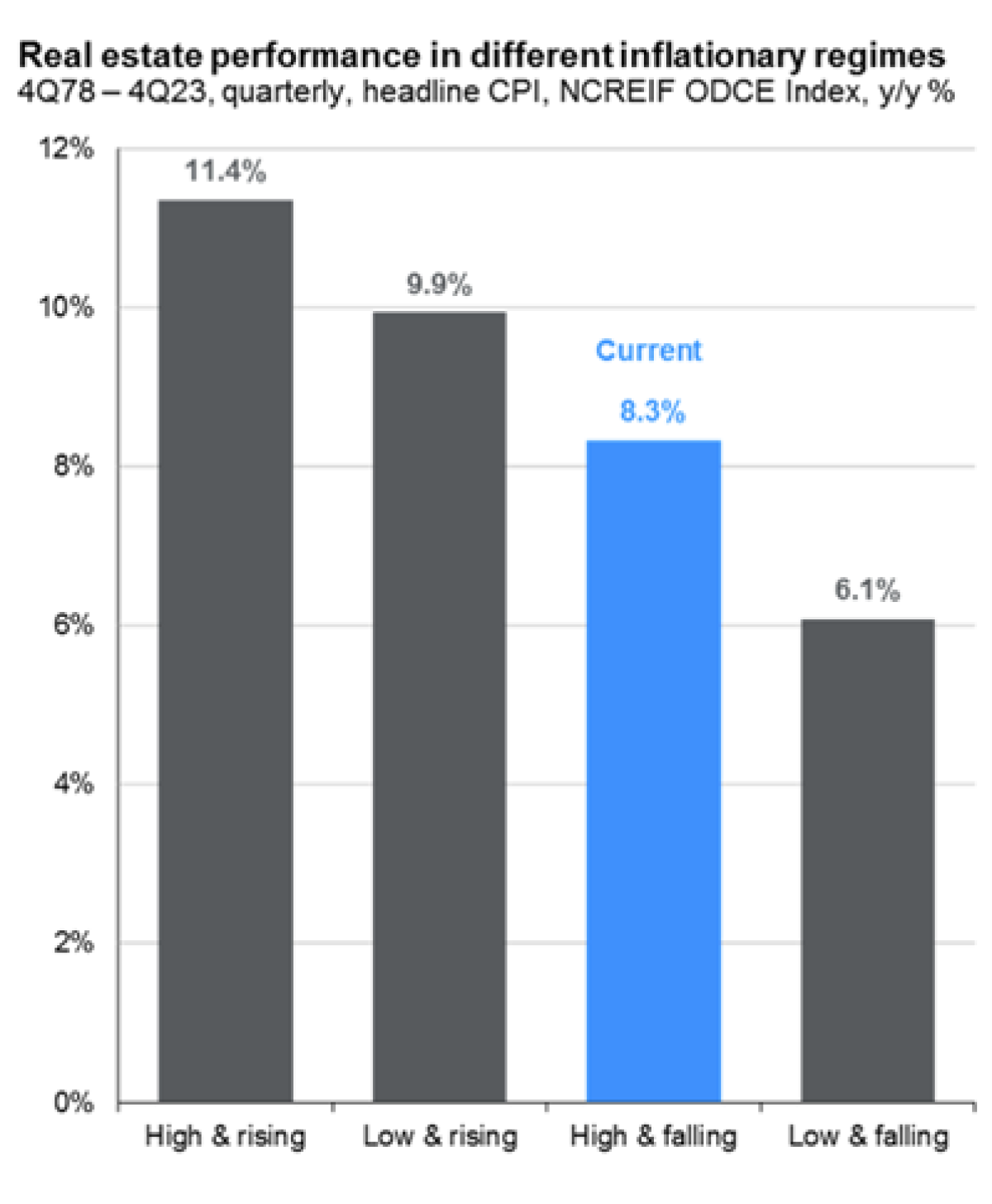
Source: JPMorgan
In the most recent JPMorgan’s Guide to Alternatives, real estate should be expected to return an attractive absolute return, albeit lower than the “High & Rising” or even “Low & Rising” environments we’ve experienced over the last few years.
Supply and Demand
Finally, in addition to interest rates and inflation, real estate is driven by supply and demand. In their annual outlook, PGIM forecasts a continued decline in supply, driven primarily by higher construction costs, falling property values, and the drag on credit formation the industry has experienced as of late. However, the expected decline in supply is not uniform across the board either, with global office and retail expecting the worst declines whereas industrial and logistics may actually be positive.
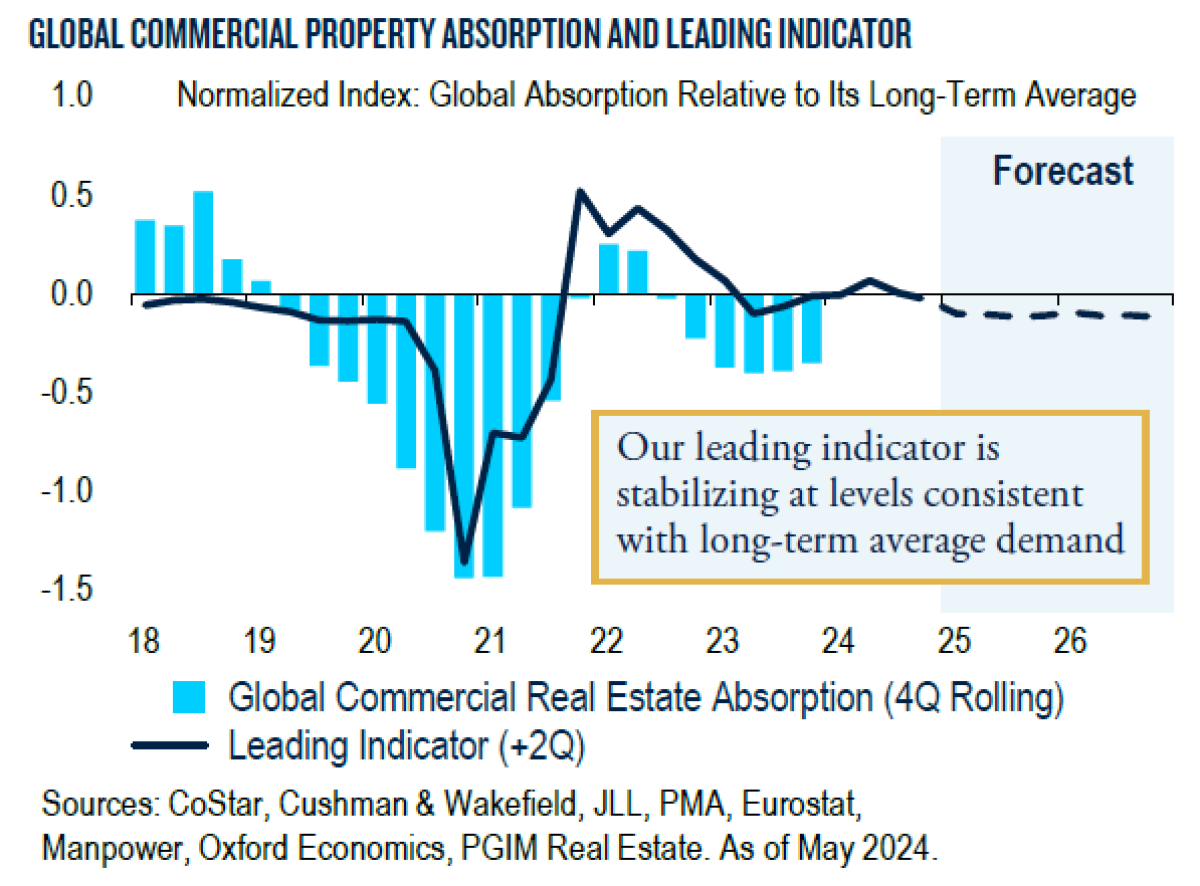
Similarly, as global economies recover and/or stabilize, PGIM expects demand growth to remain positive, as labor markets improve, and household spending picks up.
However, just as supply changes by sector, so too does demand. A stat to continue watching is the vacancy rates found across certain property types. A Statista chart shows vacancy rates, where a very clear differential between office and other sector still exists.
Long-Term Opportunities
So where are the longer-term opportunities? According to Nuveen’s Real Estate Outlook, they identify the following:
- Industrial real estate – as generative A.I. and electrification drive greater demand for data centers and battery/chip manufacturing, respectively, industrial real estate should be expected to garner strong demand.
- Affordable housing - There is a clear shortage of affordable housing options, particularly in the United States. In fact, Zillow estimates that there is a shortage of 4.3 million homes today. To compound things further, homes have become unaffordable for the average buyer – rising 44% between 2020 and 2023. Holding all of this constant, there will continue to be a strong demand for affordable housing options from families.
- Senior housing – Similar to the affordable housing crisis, Nuveen notes that t 10% of the global population is older than 65 years old today versus just 8% in 2013, which equates to an additional 228 million seniors. They expect this problem to exacerbate as the Baby Boomer generation ages into this new age bracket, forecasting 800 million more seniors globally by 2050.
Finally, these trends must also be addressed with sustainability issues in mind. For example, on the climate side, many organizations have committed to net-zero emissions and will have strong preferences for new builds and existing builds to minimize greenhouse gas emissions and ensure physical and/or transition risks are minimized.
Putting It All Together
This isn’t your millennial’s real estate market. Real estate is and will continue to evolve over the next several years, as capital is rationalized, the cost of borrowing stabilizes, and many of the cyclical and secular trends find their equilibrium and begin to play out, respectively.
Importantly, just like any other asset class, selection will matter now that the cost of capital is greater than zero. Sectors, property locations, and geographies matter, as the dispersion of returns within the real estate complex will tell the story more than the broad “real estate” label ever could.
If you’re interested in a deeper dive, listen in on a recent webcast where we discussed some of the largest trends real estate investors can expect in the coming months and years.
About the Author:
Aaron Filbeck, CAIA, CFA, CFP®, CIPM, FDP oversees UniFi by CAIA™, a learning platform dedicated to educating the private wealth management industry on alternative investments. He was previously responsible for leading and implementing CAIA Association's content agenda, thought leadership initiatives, and content development for the CAIA Charter Program.

Aaron is a frequent speaker and writer on various topics of alternative investments and his work has been published in CAIA’s educational programs, numerous academic journals, books, and industry publications. Aaron’s industry experience lies in private wealth management, where he oversaw asset allocation, portfolio construction, and manager research efforts for high-net-worth individuals and institutional retirement plans.
He earned a B.S. with distinction in Finance and a Master of Finance from Penn State University. He holds the Chartered Alternative Investment Analyst (CAIA), Chartered Financial Analyst (CFA), Certificate in Investment Performance Measurement (CIPM), and Financial Data Professional (FDP) designations, and is a CERTIFIED FINANCIAL PLANNER™. He is a Past President of CFA Society Columbus and serves as a board director and Programs Chair for CFA Society Philadelphia. Aaron is an adjunct professor and serves on multiple advisory boards for Penn State University.




